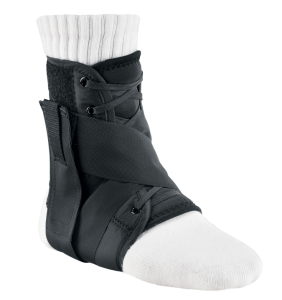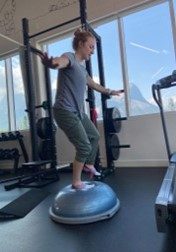Lateral Ankle Sprains
A…“lateral ankle sprain is the most common injury in sports, with up to 40% of patients developing chronic ankle instability (CAI)”
– Picot et al. (2022)

It’s the season for trail running, hiking, and outdoor field sports!
Moving over uneven terrain, which on the trails includes lots of rocks and roots, requires focus and good ankle stability.
Ankle sprains are the most common sudden injury in trail runners and have been reported to account for 11-20% of all injuries in sport.
Of these ankle sprains, about 77% are lateral ankle sprains, where the ligaments on the outside of the ankle are injured.
The anterior-talo-fibular-ligament (ATFL) is the most common lateral ankle ligament injured, followed by the calcaneo-fibular-ligament (CFL).
Types of ankle sprains
Ankle ligament sprains, like other ligament sprains, are graded as I, II, or III.
- Grade I sprains typically have mild to moderate swelling with little to no bruising and usually resolve in about 4-6 weeks.
- Grade II sprains have more swelling and bruising due to more ligament fiber tears, which means it may take anywhere from 8-12 weeks to recover.
- Grade III sprains mean that the ligament is completely torn, requiring 12+ weeks of rehabilitation or sometimes surgery.
Seeing as lateral ankle sprains are one of the most common injuries in sport, they are often overlooked as minor nuisances that may hold you back for a couple of weeks at most.
However, if you have already sustained an ankle injury, you are more than three times as likely to sustain another ankle injury compared to someone who has never injured their ankle.
In addition, more than 50% of people who sprain their ankle do not seek formal medical treatment and many return to sport with ongoing impairments. So it’s not something to be taken lightly!
Management of ankle sprains
Most people have heard of R.I.C.E. or P.R.I.C.E. or maybe even P.O.L.I.C.E., but have you heard of P.E.A.C.E. & L.O.V.E.?
Owner of The Running Clinic, Blaise Dubois, expands on this acronym in this short article.
How can we apply this principle to a lateral ankle sprain?
Protection will depend on the severity of an acute ankle sprain. If you are limping because of pain, then crutches for a couple of days can help restore normal walking ability. If you are unable to put any weight on your foot, then you may require an x-ray to rule out any injury to the bones. Clinicians will often use a guideline called the Ottawa Ankle & Foot rules to determine whether an x-ray is necessary.
Anti-inflammatories and ice are topics that continue to be debated when it comes to ankle sprains. Although inflammation is part of the body’s natural healing process, higher grade ankle sprains can produce a significant amount of swelling that limits progress in restoring range of motion and function. Minor sprains with moderate swelling that improves quickly may not require anti-inflammatories or ice, however high grade sprains with significant swelling may benefit from more rest breaks where you spend more time relaxing with ice on your elevated foot. Contrast baths, which involve rotating between hot water and ice water, may increase superficial blood flow and have a role in pain and swelling management during the transition from acute to chronic phases. On the other hand, exercise is a great way to increase local circulation.
Hyaluronic acid injections, for example SportVis, may be beneficial for grade II ankle sprains, however timing is key. The recommended dose is two injections separated by three days shortly after injury.
Ask your healthcare professional more about it, or visit our Acute Injury Clinic to get assessed and speak with one of our sport medicine physicians.

Bracing. Using an ankle brace can be helpful in the initial phases of recovery to prevent re-injury while you are working on regaining strength and proprioception (your sense of movement, force, and body position). Use of the brace should be gradually weaned as your healing, abilities, and confidence progress.
For less severe ankle sprains, research supports using a more flexible brace option versus a rigid one to promote earlier return to movement or activity.
— Visit the BSM Shop to see what ankle braces we have available —
Exercise! The ankle ligaments have little receptors called proprioceptors that help to tell us where our ankle is in space. When we step on an uneven surface and the ligament gets stretched, it tells us and our muscles to correct the position to help prevent injury.
When a ligament is sprained, it means that fibers are already stretched or torn, sometimes giving us this signal too late to correct or prevent re-spraining it.
This is why exercise is an essential part of ankle sprain rehabilitation. We need to make all the muscles around the ankle strong and re-train their position sense. This often starts with restoring the up and down movements, performing light strengthening with the dreadfully boring (but helpful) exercise bands in all directions, and simple balancing exercises on flat ground.
It’s important that you don’t stop here, but continue to progress to exercises that look more like your sports over time. For example balancing on inclines for hiking and trail running, or jumping, cutting and changing directions for soccer.
Example Exercises
Here are some brief (!) examples of exercises you can do during each phase of your recovery.
It’s always best, however, to check in with your health care practitioner to individualize your program to make sure it’s right for you.
Early Phase
Use of theraband anchored to table leg etc and single leg balance on flat ground.
- Ankle eversion (peroneals muscle strength) – point your toes down and outwards into the band
- Ankle inversion (tibialis posterior muscle strength) – point your toes down and inwards into the band
These ankle exercises are often used in the first 1-3 weeks of recovery depending on the severity of your sprain. Aim to repeat 3 sets until you fatigue once a day. In physiotherapy I usually progress from these easier (not super exciting) exercises once someone has good ankle strength similar to their other side with manual muscle testing.
Mid Phase
Single leg calf raises, balance on uneven surfaces & on inclines with banded rotation (facing sideways and downwards).
Single leg calf raises: stand off the edge of a step, holding the railing/wall for balance, raise your heel as high as you can without using momentum and slowly lower back down
Balance on uneven surfaces: try using a BOSU, core balance disc, foam pad, wobble board, pillow, or folded towel
Balance on inclines: use a slant board/wedge (a piece of plywood propped up can work as well) or find a hill outside. Option1: stand sideways on the downhill leg and rotate towards that foot, adding a band for increased difficulty. Option 2: stand facing downhill on one leg and rotate towards the weight bearing foot, adding a band for increased difficulty.
Late Phase
Hopping
Return to Sport and Activity
In a recent study, 155 panelists from 19 countries, 6 professions, and 15 sports reached a consensus on five areas covering 16 items that should be assessed when making return to sport decisions after lateral ankle sprains. They named this the PAASS Framework.
In this particular study they did not elaborate on the specific tests/activities that can be used to assess patients. However, a study by Picot et al. (2022) reviewed the research literature and gave some good examples of measures and tests that can be used to assess if people with lateral ankle sprains can/should return to sport.
Prevention
What is the best way to avoid developing chronic ankle instability?
Prevention to avoid spraining your ankle in the first place!
One quick and easy screening tool to check if you are at higher risk of spraining your ankle is the “Y Balance Test” (YBT).
Studies have reported that an asymmetry of 4cm or more in the anterior (forward) direction increases the risk of lower limb injury by 2.2-2.7 times.
Check out the video below to test yourself!
The FIFA 11+ is a warm up routine specifically designed for soccer players to prevent injury. A recent study with collegiate female soccer players reported that the players who performed the FIFA 11+ regularly for three consecutive seasons decreased ankle joint injuries by 83.3%.
Another study conducted right here in Calgary found that “a soccer-specific neuromuscular training programme, including a home-based wobble board component, can reduce the risk of injury by over one-third in youth indoor soccer players”.
I’m sure most of us have recognized that we’re much more likely to mis-step when we are fatigued. While hiking or trail running, staying inside your abilities for time, distance, and elevation will help keep your strength, focus, and reaction time from deteriorating and potentially leading to injury.
If you sprain your ankle, then after an initial relative rest period you will want to start working on exercises for secondary prevention to improve balance and proprioception. These exercises will look a lot like the primary prevention exercises (like in FIFA 11+) or the examples listed above under management.
Overall, working on strength, balance, and motor control is rarely a bad thing, and does appear to have a protective effect against lateral ankle sprains.
That being said, sometimes accidents or trauma still happen. It’s important that you treat a lateral ankle sprain with the appropriate time and attention post injury to make sure you return to your activities at the right time to prevent developing a chronic instability.
Expert Contributor
ALY WALFORD, PHYSIOTHERAPIST
MScPT, BScRehabSc, IMS
A strong believer in teamwork and an active approach, Aly is excited to work with you to help you navigate through your injury, recovery, and return to activity/performance. Aly completed her Bachelor’s of Science and Master’s of Physical Therapy at McGill University. Since graduating, she has taken courses in manual therapy, biomedical dry needling (IMS), pelvic health (Treating & Training the Female Athlete), and ACL rehab to name a few. Aly is a certified Pelvic Health specialist and treats women 18yrs+.
A passionate runner and member of the Canadian National Ski Mountaineering Team, you can often find Aly out playing or training in the mountains year round.
References
Al Bimani, S. A., Gates, L. S., Warner, M., & Bowen, C. (2019). Factors influencing return to play following conservatively treated ankle sprain: a systematic review. The Physician and Sportsmedicine, 47(1), 31-46.
Altomare, D., Fusco, G., Bertolino, E., Ranieri, R., Sconza, C., Lipina, M., … & Di Matteo, B. (2022). Evidence-based treatment choices for acute lateral ankle sprain: a comprehensive systematic review. Eur Rev Med Pharmacol Sci, 26(6), 1876-1884.
Dubois, B., & Esculier, J. F. (2020). Soft-tissue injuries simply need PEACE and LOVE. British journal of sports medicine, 54(2), 72-73.
Emery, C. A., & Meeuwisse, W. H. (2010). The effectiveness of a neuromuscular prevention strategy to reduce injuries in youth soccer: a cluster-randomised controlled trial. British journal of sports medicine, 44(8), 555-562.
Magoshi, H., Hoshiba, T., Tohyama, M., Hirose, N., & Fukubayashi, T. (2023). Effect of the FIFA 11+ injury prevention program in collegiate female football players over three consecutive seasons. Scandinavian Journal of Medicine & Science in Sports.
Petrella, M. J., Cogliano, A., & Petrella, R. J. (2009). Long-term efficacy and safety of periarticular hyaluronic acid in acute ankle sprain. The Physician and Sportsmedicine, 37(1), 64-70.
Picot, B., Hardy, A., Terrier, R., Tassignon, B., Lopes, R., & Fourchet, F. (2022). Which functional tests and self-reported questionnaires can help clinicians make valid return to sport decisions in patients with chronic ankle instability? A narrative review and expert opinion. Frontiers in sports and active living, 4, 902886.
Smith, C. A., Chimera, N. J., & Warren, M. E. G. H. A. N. (2015). Association of y balance test reach asymmetry and injury in division I athletes. Medicine and science in sports and exercise, 47(1), 136-141.
Stanton, D. E. B., Lazaro, R., & MacDermid, J. C. (2009). A systematic review of the effectiveness of contrast baths. Journal of Hand Therapy, 22(1), 57-70.
Vincent, H. K., Brownstein, M., & Vincent, K. R. (2022). Injury prevention, safe training techniques, rehabilitation, and return to sport in trail runners. Arthroscopy, sports medicine, and rehabilitation, 4(1), e151-e162.
Weerasekara, R. M. I. M., Tennakoon, S. U. B., & Suraweera, H. J. (2016). Contrast therapy and heat therapy in subacute stage of grade I and II lateral ankle sprains. Foot & ankle specialist, 9(4), 307-323.












